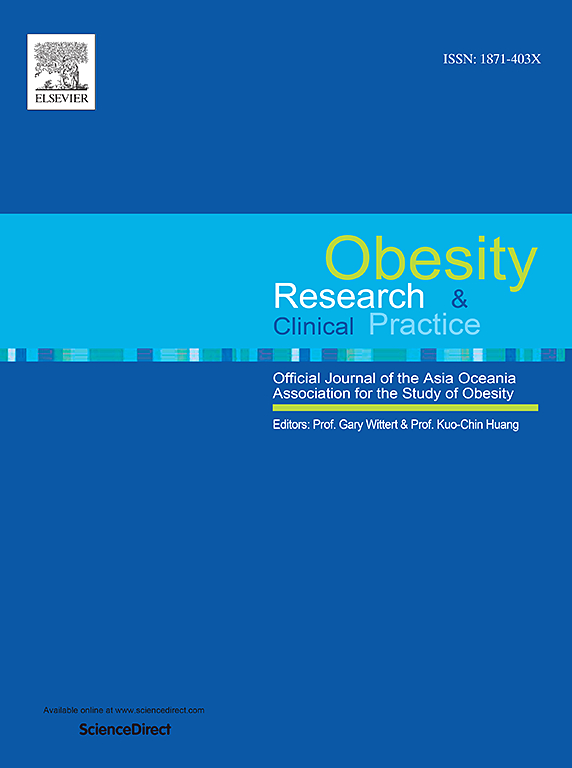Excessive dietary fat and fructose enhance hepatic lipogenesis and impair mitochondrial dynamics to cause MASLD in C57BL/6 mice
IF 2.5
4区 医学
Q3 ENDOCRINOLOGY & METABOLISM
引用次数: 0
Abstract
Objective
Metabolic dysfunction-associated steatotic liver disease (MASLD) affects around 1/3 of the worldwide population, with rising prevalence. Surplus fat and carbohydrate intake are crucial for MASLD onset. This study aimed to elucidate the interference of excess lipids and fructose (32 % as energy each), alone or in combination, on the hepatic energy metabolism of male mice.
Methods
Forty male C57BL/6 mice (3 months old) were randomly assigned to receive a control diet (C, 10 % of energy as soybean oil, n = 10), high-fat diet (HF, 32 % of energy as lard and 10 % as soybean oil, n = 10), high-fructose diet (HFRU, 32 % of energy as fructose, and 10 % as soybean oil, n = 10) or a diet rich in lipids and associated fructose (HF-HFRU, 32 % of energy as lard, 10 % as soybean oil, and 32 % of energy as fructose, n = 10) for 12 weeks.
Results
The increased consumption of saturated fat or fructose, isolated or in association, caused oral glucose intolerance, increased hepatic triacylglycerol and cholesterol, and enhanced the expression of proteins related to hepatic inflammation, lipogenesis, mitochondrial dysfunction, and ER stress, resulting in a marked increase in hepatic steatosis.
Conclusion
Our results showed that high consumption of diets rich in lipids and fructose contributed to the development of MASLD and revealed an intimate relationship between altered mitochondrial dynamics and ER stress. Understanding the molecular pathways that regulate the accumulation of hepatic lipids can lead to promising therapies for MASLD.
过量的膳食脂肪和果糖会促进肝脏脂肪生成并损害线粒体动力学,从而导致 C57BL/6 小鼠的 MASLD。
目的:代谢功能障碍相关的脂肪变性肝病(MASLD)影响全球约1/3的人口,且患病率不断上升。过量的脂肪和碳水化合物摄入对MASLD的发病至关重要。本研究旨在阐明过量脂质和果糖(各占32% %的能量)单独或联合对雄性小鼠肝脏能量代谢的干扰。方法:40雄性C57BL / 6小鼠(3个月)被随机分配接受控制饮食(C, 10 %的能量大豆油,n = 10),高脂肪饮食(高频,32 能源猪油和10 % %豆油、n = 10),高果糖饮食(HFRU, 32 果糖%的能量,和10 %豆油,n = 10)或饮食中富含脂质和相关果糖(HF-HFRU, 32 %的能量猪油,10 %豆油,和32 %的能量作为果糖,n = 10)为12周。结果:增加饱和脂肪或果糖的消耗,无论是单独的还是联合的,都会引起口服葡萄糖耐受不良,增加肝脏甘油三酯和胆固醇,并增加与肝脏炎症、脂肪生成、线粒体功能障碍和内质网应激相关的蛋白质的表达,导致肝脂肪变性显著增加。结论:我们的研究结果表明,大量摄入富含脂质和果糖的饮食有助于MASLD的发展,并揭示了线粒体动力学改变与内质网应激之间的密切关系。了解调节肝脂质积累的分子途径可以为MASLD带来有希望的治疗方法。
本文章由计算机程序翻译,如有差异,请以英文原文为准。
求助全文
约1分钟内获得全文
求助全文
来源期刊

Obesity research & clinical practice
医学-内分泌学与代谢
CiteScore
7.10
自引率
0.00%
发文量
80
审稿时长
49 days
期刊介绍:
The aim of Obesity Research & Clinical Practice (ORCP) is to publish high quality clinical and basic research relating to the epidemiology, mechanism, complications and treatment of obesity and the complication of obesity. Studies relating to the Asia Oceania region are particularly welcome, given the increasing burden of obesity in Asia Pacific, compounded by specific regional population-based and genetic issues, and the devastating personal and economic consequences. The journal aims to expose health care practitioners, clinical researchers, basic scientists, epidemiologists, and public health officials in the region to all areas of obesity research and practice. In addition to original research the ORCP publishes reviews, patient reports, short communications, and letters to the editor (including comments on published papers). The proceedings and abstracts of the Annual Meeting of the Asia Oceania Association for the Study of Obesity is published as a supplement each year.
 求助内容:
求助内容: 应助结果提醒方式:
应助结果提醒方式:


